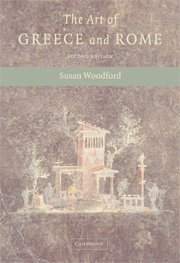Book contents
- Frontmatter
- Contents
- List of Illustrations
- Acknowledgements
- Maps
- Introduction
- PART I THE ARCHAIC AND CLASSICAL PERIODS: PROGRESS AND PROBLEMS
- PART II THE FOURTH CENTURY BC AND THE HELLENISTIC PERIOD: INNOVATION AND RENOVATION
- PART III THE ROMAN WORLD: ADOPTION AND TRANSFORMATION OF THE GREEK LEGACY
- 7 Roman Statues and Reliefs
- 8 Roman Painting
- 9 Roman Architecture: Adaptation and Evolution
- 10 World Rulers
- Epilogue
- Appendix: How We Know What We Think We Know
- Glossary
- Further reading
- Index
8 - Roman Painting
- Frontmatter
- Contents
- List of Illustrations
- Acknowledgements
- Maps
- Introduction
- PART I THE ARCHAIC AND CLASSICAL PERIODS: PROGRESS AND PROBLEMS
- PART II THE FOURTH CENTURY BC AND THE HELLENISTIC PERIOD: INNOVATION AND RENOVATION
- PART III THE ROMAN WORLD: ADOPTION AND TRANSFORMATION OF THE GREEK LEGACY
- 7 Roman Statues and Reliefs
- 8 Roman Painting
- 9 Roman Architecture: Adaptation and Evolution
- 10 World Rulers
- Epilogue
- Appendix: How We Know What We Think We Know
- Glossary
- Further reading
- Index
Summary
GREEK INSPIRATION FOR ROMAN PAINTING
The Romans admired Greek painting as much as they admired Greek sculpture and encouraged the artists they employed to make copies of particularly famous or popular Greek works for them (Figs. 104 and 105). Single figures, groups and entire panel paintings were reproduced, adapted, spoiled or beautified according to the ability of the painters and the demands of the patrons.
While Greek painting has been largely lost, a great deal of Roman painting has survived. Most of what we have comes from the walls of private houses and public buildings in Pompeii and Herculaneum, two provincial but fashionable towns that were buried when Vesuvius erupted in ad 79. A few other paintings have also been found in Rome and elsewhere. It appears that the Romans decorated their walls with mural paintings much more frequently than did the Greeks.
The impression given by this abundant material is generally attractive, occasionally beautiful, but taken as a whole second-rate and derivative.
AN EXAMPLE OF A THOROUGHLY ROMAN PAINTING
Some paintings seem untouched by the pervasive Greek influence. One such is a lively portrayal of a riot in the amphitheatre in Pompeii (Fig. 106). This was a real event: a fight broke out between the Pompeians and visitors from nearby Nocera in ad 59, and the disturbance was so great that the emperor ordered the amphitheatre closed for ten years after the fray.
- Type
- Chapter
- Information
- The Art of Greece and Rome , pp. 101 - 108Publisher: Cambridge University PressPrint publication year: 2004



